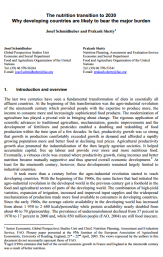
The Nutrition Transition to 2030: Why Developing Countries are likely to Bear the Major Burden

Introduction Excerpt
The last two centuries have seen a fundamental transformation of diets in essentially all affluent countries. At the beginning of this transformation was the agro-industrial revolution of the nineteenth century which provided people with the expertise to produce more, the income to consume more and increasingly sophisticated food products. The modernization of agriculture has played a pivotal role in bringing about change. The rigorous application of scientific advances to traditional agriculture, mechanization, genetic improvements and the development of fertilizers and pesticides enabled a doubling and redoubling of food production within the time span of a few decades. In fact, productivity growth was so strong that growth in production comfortably exceeded growth in demand and afforded a rapidly growing population more and better food at declining real prices. Agricultural productivity growth also promoted the industrialization of the then largely agrarian societies. It helped accumulate capital, free up labour and provide ever more and more nutritious food. Eventually, a virtuous circle was created where productivity growth, rising incomes and better nutrition became mutually supportive and thus spurred overall economic development. At least for the nineteenth century, however, these developments remained largely limited to industrial countries.
- Issue:
- Demography, Urbanization and Migration
- Region:
- Global
- Year Published:
- 2005
- Authors:
- Josef Schmidhuber, Prakash Shetty
- Institutions:
- Food and Agriculture Organization (FAO), United Nations

